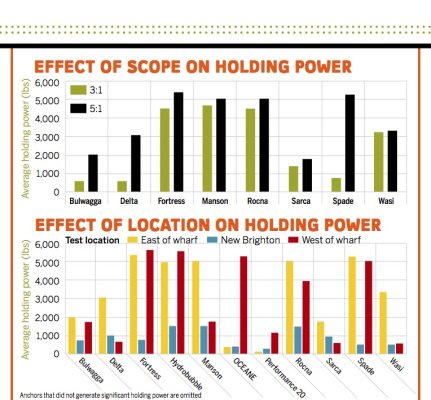psneeld - I would have expected the Fortress to do well though I had not appreciated how much better it would be when set at 45 degrees - so this was news to me. I would have thought 'better' but I would not have guessed that much better.
So from Fortress point of view they have educated me, accepting I'm pretty ignorant of this topic.
But I equally would never, ever, have guessed that other anchors would be so poor, not much better than dragging a mushroom weight along. Nor would I have ever thought that the Ultra would be that much better then a Spade, or a Mantus that much better then a Rocna. I note others do not accept the results based on their own experiences but I'm sufficiently comfortable with what Fortress have done to 'ignore' those anecdotal comments and when in thin mud I'll not deploy my Spade or (rush off and buy a Mantus) I'll simply deploy my Fortress at 45 degrees (and if asked I'd suggest others rush off and buy a Fortress (if they do not already have one).
If you sail Australia's east coast, from all the way north to all the way south, you will encounter a huge cross section of seabeds, coral (calcium) sand, pure silica sand, clay, weed of various types and densities and mud of varying consistencies (many of the anchorages are in very slow moving rivers). Many make the passage north in the winter, from Sydney (or Melbourne) to The Reef, and slightly less many make the passage south to Tasmania in the summer (there are possibly 60-70 vessels visiting Tas as I type - there is a 2 yearly circumnavigation in 2015).
Anyone cruising up and down the coast needs an anchor armoury to suit this cross section, so unlike you they will need to be able to anchor in thin mud and a Fortress looks dependable and has other positive characteristics to make it a 'must have'. Relying on another type of anchor, in thin mud, looks questionable - yes (according to some) it might work - but you would look very, very stupid if you have looked at the Fortress results and then ignore the lessons.




